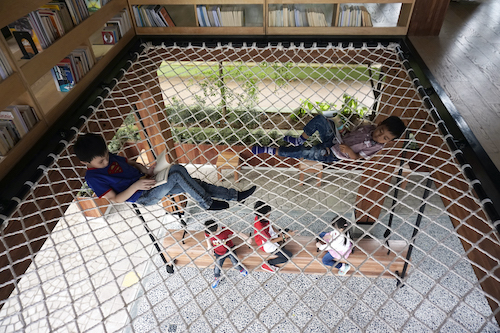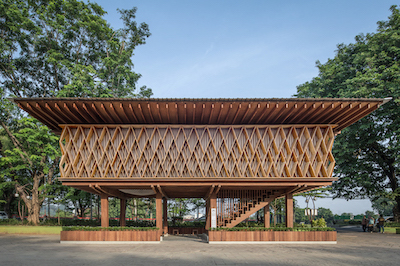Microlibrary Warak Kayu
August 18, 2020
The Microlibrary Warak Kayu is the latest addition to the iconic architecture landscape of Semarang, the capital of Central Java in Indonesia, and the fifth built project within SHAU’s Microlibrary series. It is built at Taman Kasmaran, a public square in the city centre with direct proximity with a river. The current mayor of Semarang, Hendrar Prihadi, has announced his enthusiasm on the new library, where it will be part of the city’s tourism route. In that sense the library serves not only the local neighbourhood but is also embedded in the larger city network.
By elevating the library, various spatial configurations and programmes can be offered. On the ground, a large semi outdoor area can be used for workshops. A wide tribune seating at the entrance is available for presentations or movies. The ground area is framed by planter boxes to create a more intimate atmosphere. Upstairs in the library itself, there is a net where children can lie down, relax and read but also communicate directly with their parents and friends in the space underneath. It is important to have this multi-programmatic approach to make the library a popular place, since reading alone is not yet considered a fun activity in the country.
Environmental performances: climate design, material and construction
The microlibrary is designed around passive climatic design aspects: no air conditioning is used, therefore no energy is spent. Semarang has a tropical climate, with temperatures up to 34 degrees Celsius during the end of a dry season. The building is thus cooled down by means of cross ventilation and solar heat is prevented from entering with the use of shading elements.
The roof overhang provides shading around noon. The longer façades are oriented north-west and south-east due to site restrictions. Therefore, an egg-crate like deep screen is designed to block the lower sun altitude angles in the day. This limits and diffuses direct sunlight entering the building, providing sufficient daylight in the interior of the library for reading without artificial lighting. The cross ventilation feature also helps to reduce humidity in the building and prevent the books from getting mouldy or damaged.
The first library in Indonesia made entirely of FSC-certified wood
The building could be seen as a living educational spot for wood material and construction techniques. For the Microlibrary Warak Kayu, all wood materials are in compliance to the SVLK (Indonesian Legal Wood) and FSC (Forest Stewardship Council) certification. The distinctive façade is takes the form of a diamond pattern, akin to a local mythical creature the Warak Ngendog and its dragon-like skin, displayed during annual festivals in Semarang. Hence the name of the project Warak Kayu in Indonesian, which means Wooden Warak, a positive narrative for communicating the design to a wider audience.
Wood as construction material outperforms many other materials in regard to embodied energy, water and air pollution, and carbon footprint; it is also an organic material. Wood is sustainably logged in Central Kalimantan, then shipped from Sampit over the Java Sea southwards to Semarang (Java) and the factory. The whole process also includes nursery, replanting and harvesting time planning to maintain sustainability for the coming years.
PROJECT DATA
| Project Name | Microlibrary Warak Kayu |
| Location | Semarang, Indonesia |
| Completion Date | 1 March 2020 |
| Site Area | 1,000 square metres |
| Gross Floor Area | 182 square metres |
| Number of Rooms | 1 |
| Building Height | 6.65 metres |
| Client/Owner | Arkatama Isvara Foundation |
| Architecture Firm | SHAU Indonesia |
| Principal Architects | Florian Heinzelmann & Daliana Suryawinata |
| Main Contractor | RAH (construction and assembly); PT. Kayu Lapis Indonesia (Prefabrication) |
| Civil & Structural Engineers | Joko Agus; Catur Wibowo |
| Images/Photos | KIE & team |
To read the complete article, get your hardcopy at our online shop/newsstands/major bookstores; subscribe to FuturArc or download the FuturArc App to read the issues.



